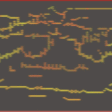The filter bank consists of resonators whose characteristic frequencies are ordered tonotopically. By tonotopy, we mean any monotonically increasing function of frequency, such as the logarithm. The proposed filter bank differs from other cochlea filter banks in its substantial inter-filter feedback. Each filter may be coupled to all other filters at higher frequencies. The feedback enhances the filter bank response for a selective range of frequency modulations. For a filter bank design based on the human cochlea, this range coincides with formant movements in speech signals. Decreasing inter-filter feedback has little effect on the response at the location of formants, but significantly attenuates their changes. In the case of feedback from only the adjacent higher-frequency filter, the filter bank reduces to a delay line. Because formant dynamics encode perceptual information, this filter bank may be useful as initial analysis for automatic speech recognition. The filter bank design derives from a three-dimensional solution to the equation of motion of the basilar membrane. In particular, the inter-filter coupling constants depend quadratically on the breadth of the basilar membrane, which may vary along its length. Increasing inter-filter feedback sharpens the frequency responses of individual filters. We describe a DSP implementation of a design based on the physical properties of the average human cochlea. Cochleagrams for various sample signals, including some speech signals, demonstrate the enhancement of formant movements. This design is currently used as a front-end processor to a speech recognizer.
Proc. International Conference on Signal Processing Applications and Technology, pp.1674-1678, 1997
